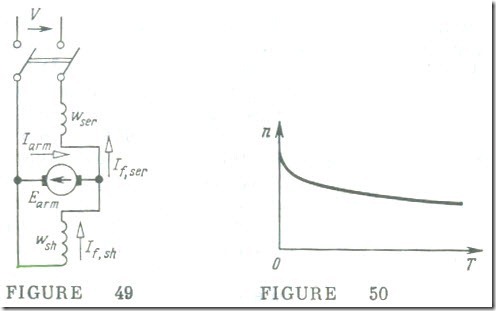The Compound Motor
The shunt motor has a flat speed-torque characteristic and the series motor has. a falling speed torque characteristic . in some applications it is desirable to have some intermediate from . the simplest way to achieve this objective is to use a compound motor. In a compound motor motor, one winding (series or shunt ) supplies the bulk (at least 70% of the mmf and the other winding (shunt or series ) supplies the balance fig 49 in most cases the series and shunt-field windings are so connected that their mmfs aid each other and the machine is said to be “cumulative compound” .
If we consider the two Windings of acompound motor separately that is neglecting the effect of magnetic saturation the speed equation for such a motor may be written in the following general from
Where rf,ser is the resistance of the series-field winding.
The series flux Φscr may be expressed in terms of the armature current and the reluctance of the machine (see sec.13.14) so that Eq(13.15) can be re-arranged as follows :
The above equation defines the speed-vs-armature current characteristic of a compound motor.
In a series-shunt motor, series excitation is predominant, but the shunt-field winding limits the rise in speed as the load on the motor is decreased (Fig. 50).
In a shunt-series motor, shunt excitation is predominant, and the weak series-field winding stabilizes the main magnetic flux and makes the speed-torque characteristic more drooping.
A compound motor is reversed by interchanging the connections to the armature only, so as to reverse the direction of armature current.



